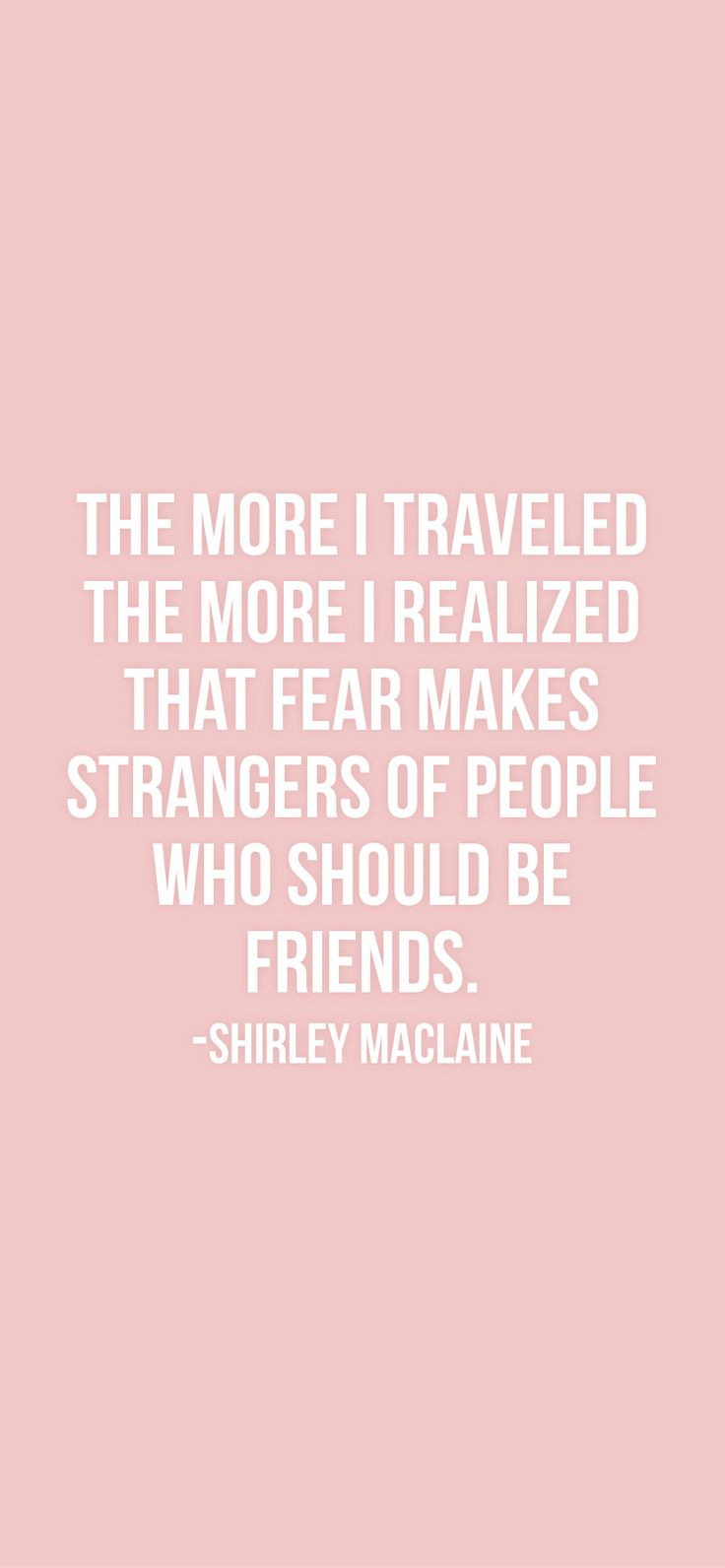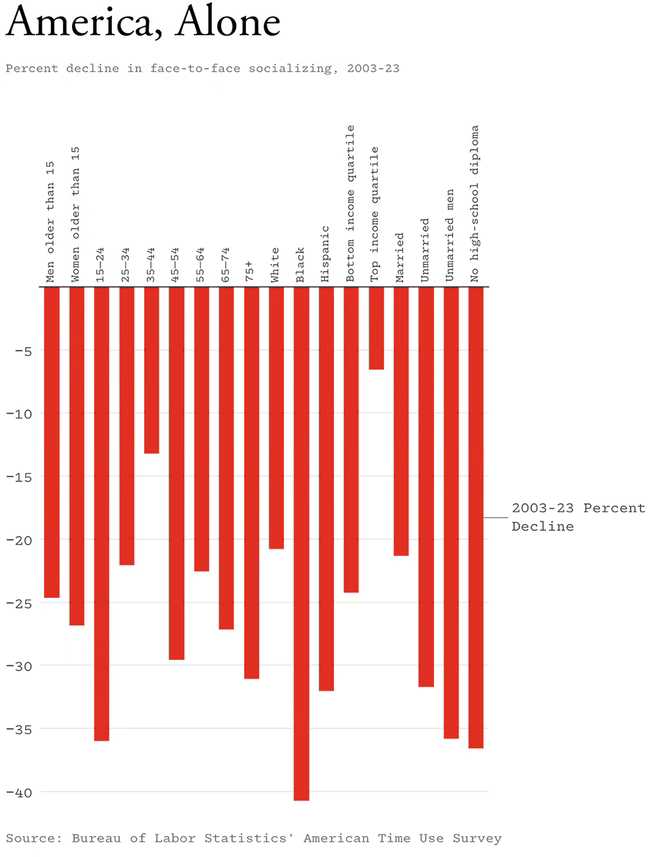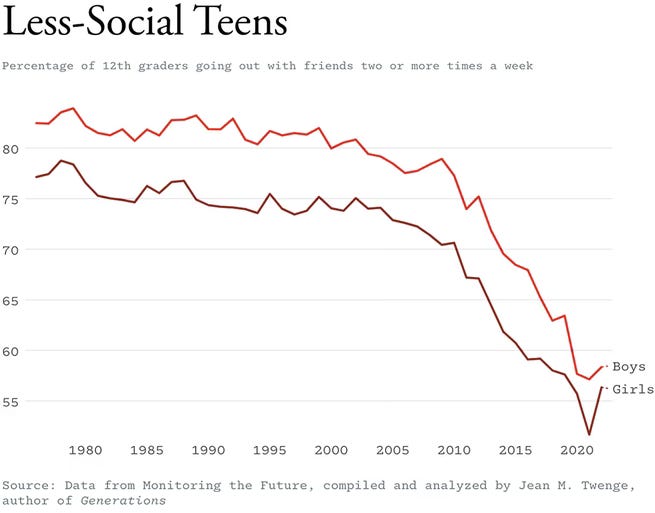No One Should Be A Stranger
On the loneliness epidemic & being more together
The summer of 2023 was really difficult for me, and I experienced social isolation. Many friends moved away after finishing the Master’s program (and I’m sure they faced similar difficulties in reestablishing their communities). On top of that, Andrea was recovering from a torn ACL and then got COVID, then there was wildfire smoke from Canada that kept me & my asthma inside, then I got COVID! To cope with this, I didn’t reach out to many people like I usually do. Instead, I got really into playing Civilization 6 online with a couple friends from undergrad, which ended up usually with me playing by myself late into the night, saying I’ll stop after “one more turn” which turned into 1 or 2 AM.
You may know me as one of the most social people you know. We may have met at a potluck or social event that I organized, or because I made vigorous eye contact with you too many times while waiting in line. I consider myself the opposite of lonely or socially isolated.

My experience of loneliness and social isolation is not uncommon. Everyone I’ve talked with about this has experienced this some way or another. Most Americans, at some point feel lonely or socially isolated, especially after the pandemic. “Almost half of Americans (49%) in 2021 reported having three or fewer close friends.” Experiencing loneliness is as bad for your health as smoking 15 cigarettes a day. If you’re lonely, you’re twice as likely to die prematurely.
I read the Surgeon General’s op-ed on the loneliness epidemic, and then the 82-page HHS report on “Our Epidemic of Loneliness and Isolation” and then his book, Together, and I hope to share with you some insights from those, as well as some of the tools and ideas I’ve gathered over my years of being social, organizing, and seeking more authentic relationships.
We humans are social creatures. Loneliness and social isolation are related to everything, from our physical and mental health, to our relationships with technology, to our relationships with each other, our communities, our democratic institutions, and the culture we create. It is shaped by our built environment, our access to transportation, our culture, our wealth, our age, and so much more. It is time we reconsider every facet of our lives that divides us or keeps us from connecting with others, and reexamine how to live meaningful, intentional lives in relation to each other. If we get this right, we can be more joyous and empathetic, build more trust in our neighbors, share our wealth and opportunities, care for each other, and build more just and equitable communities, cities, countries, and worlds.
As you continue with your day: I ask you to think about connections in your life.
Are you lonely? Do you see people you love, who care about you, regularly?
Reach out to a friend. Talk to stranger!
Start a group that meets regularly around something that interests you.
How bad is loneliness & social isolation1 in America?
One in two adults in America is experiencing loneliness. Loneliness is a spectrum, not a binary, but the more social connections you have, the better your outcome.
Loneliness is associated with a greater risk of cardiovascular disease, dementia, stroke, depression, anxiety, and premature death.
Your mortality rate as a lonely person is the same as if you smoked 15 cigarettes a day. Being lonely is more deadly than if you were obese or physically inactive.
Loneliness / Social isolation costs us a lot of money:
Social isolation among older adults is estimated to cost Medicare $6.7 billion a year in excess spending (that’s more than the entire state of Wyoming’s yearly budget).
And it costs an estimated $154 billion to employers yearly when workers don’t show up because of stress attributed to social-isolation (That’s more than the GDP of Ethiopia. It’s almost the same as what the US spends on Medicare each year).
It costs us more than money. Our social fabric is fraying: Trust in each other and institutions is near historic lows.
In 1972, polls showed 45% of Americans felt they could reliably trust other Americans. In 2016, that fell to 30%.
Political polarization is near historic highs.
Declining social networks and social participation: A study from 2003-2020 measured average time spent alone as a measure of social isolation.
Average time spent alone has been increasing, from 285-minutes a day (almost 5 hours) in 2003, to 309 minutes a day in 2019, to 333 minutes a day (5 and a half hours) in 2020. This represents 24 more hours a month spent alone.

This figure is taken from Derek Thompson’s essay: The Anti-Social Century Social participation dropped. People engaged with friends socially in-person for 60 minutes a day in 2003, to 20 minutes a day in 2020. This represents 20 hours less spent with friends per month.
The numbers are even worse for young people, ages 15-24.
Time spent in-person reduced by nearly 70%, from 150 minutes per day in 2003 to 40 minutes per day in 2020.

This figure is taken from Derek Thompson’s essay: The Anti-Social Century
Technology has made things worse:
Americans spend an average of six hours per day on digital media. One-in-three U.S. adults 18 and over report that they are online “almost constantly”
The percentage of teens ages 13 to 17 years who say they are online “almost constantly” has doubled since 2015, to around 46% in 2022.
Less Friendship 🙁
The number of close friendships has been declining too. Among people not reporting loneliness or social isolation, nearly 90% have three or more confidants (the flip side being, only 10% of people who report being lonely have three or more confidants). In 1990, 27% of Americans reported having only three or fewer close friends. In 2021, that number was 49%.
Declining Third Places:
Religious groups, clubs, labor unions and other community groups have been declining since at least the 1970s.
In 2022, 57% of Americans said they knew only some or none of their neighbors.
In 2018, only 16% of Americans reported that they felt very attached to their local community.
There’s so many problems in the world, and I feel like this one is tied to so many different parts of why the world feels broken to so many. I want to change that, I want us to work together to change that. In Baltimore, I’m trying to create more spaces to be together, and I am working with networks of people around the world to do the same!
If you’re in Baltimore & interested in any of these, let me know!
Silent Book Club Fells Point, Charm City Sings (community choir), Rock Climbing, Practicing English & Spanish, Spanish Happy Hour at Ministry of Brewing,2 Bike Party, Salsa & Bachata, Swing Dancing, Poetry Writing,3 Poetry open mics,4 Slam Poetry, Anime club,5 Running,6 Girls Who Walk, go to the library! Go to the Tool Library! Go to Patterson Park and enjoy their events. Go to Red Emma’s bookstore & to their events. Join your neighborhood association7. Do you have more to add to the list? Do you have ideas for other things you’d like to see? Let me know!
Edit: Volunteering Untapped! Volunteer at the Franciscan Center, at Breath of God Lutheran Church. The Stoop Storytelling events (like the Moth but Baltimore)! Save Your Soul Monthly dance party at Lith Hall! Ping Pong Canton, Volo Sports! Queer Dance party: Version Baltimore, Ottobar Dance nights, including Metal Mondays, Baltimore Honky-Tonk (Two-step party).8 So Far Sounds concerts. Baltimore Rock Opera Society! Baltimore Improv Group! In the summers, there’s free concerts: First Thursdays at Canton Waterfront Park, Summer Concert Series in Patterson Park, The Charles Cinema Sundays, and so much more!
Third Spaces: Meander art bar! Creative Alliance (free yoga on Saturday mornings!) & their events, the American Visionary Arts Museum & their events!
Anywhere in the world:
If you’re interested in making your neighborhood one that’s conducive for connection, there’s a neighborhood accelerator program that will teach you how to do just that! I’m in the 3rd cohort, which is about to start :)
Want to live near your close friends? Anne Helen Peterson writes: You'd Be Happier Living Closer to Friends. Why Don't You?
Or do you want to live in a cooperative housing situation? Read the Supernuclear blog!
Allie Volpe’s writing at Vox on social connection is always good. Read her 7 easy habits to live a better social life that was just published!
Do you have other ideas to make our world more connected? Want to collaborate?
Want to learn more about the loneliness epidemic?
Derek Thompson’s essay in the Atlantic, which is the best short writing I’ve found on the topic.
Ezra Klein’s podcast: The 'Quiet Catastrophe' Brewing in Our Social Lives
Vivke Murthy’s book! Get it from your local library!
I liked these posts by Joss - Loneliness: The Epidemic & The Four Circles of Belonging
Further topics I’m thinking of writing about
What I’ve learned as a formal and informal social organizer, living in a cooperative, living near your friends, calling your friends, focusing your attention when you’re with friends, potlucks and sharing, interdependence, talking with strangers, knowing your neighbors, getting off your phone & touching grass, the kid’s aren’t alright, the men aren’t alright, against American culture of independence & individualism, serving something bigger than yourself, work & wealth competing for social life, designing life & space & policy for connection, potential partnerships and programs in Baltimore, participating in the democratic process, and more!
Loneliness and social isolation are different, but related. Loneliness is feeling alone or separated. Social isolation is the lack of social contacts / having few people to interact with regularly. Most of these numbers are from the HHS report on Loneliness and Isolation.
I host this one :) Thursdays at 6pm at Ministry of Brewing
A friend hosts this one!
Hotel Revival First Monday of the Month. Hidden Palace at Fadensonnen first Thursday of the month (?), Charm
See the application details in the comments, or reach out to the OP
There’s a ton of run clubs, but this is the one I’ve been to
This is my neighborhood’s! This is the one for Upper Fells
Many of these dance things found through a Baltimore Magazine piece:

